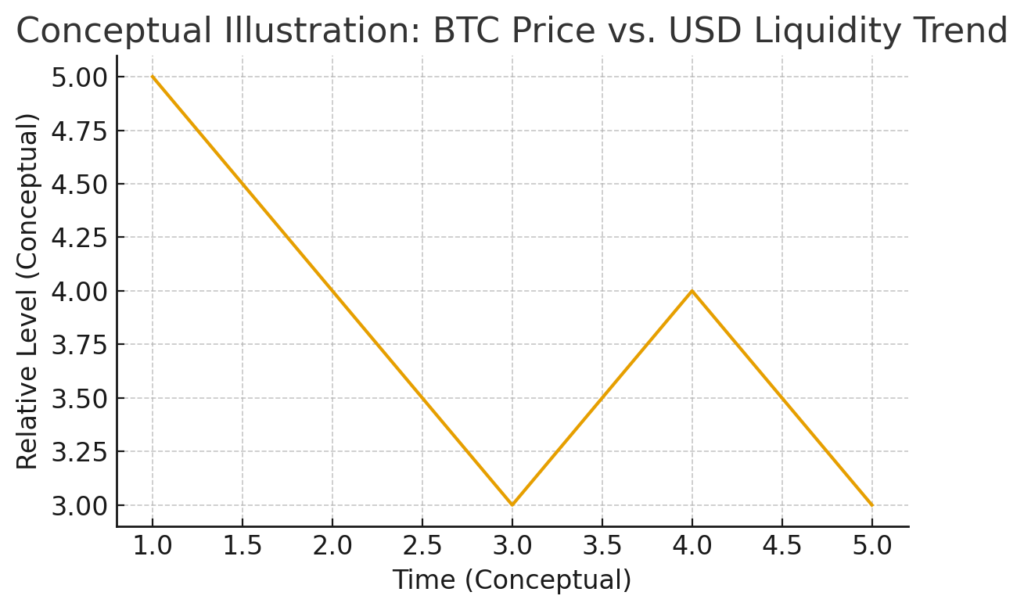
Main Points :
- Arthur Hayes warns USD liquidity contraction—not crypto-native factors—is the real driver behind Bitcoin’s downturn.
- Japan’s debate on “separate taxation” for crypto reveals deep structural issues far beyond simply lowering tax rates.
- Extreme bullish predictions—such as BTC surging to $220,000 within 45 days—reflect market psychology more than fundamentals.
1. The Macro Liquidity Squeeze: Arthur Hayes and the Real Cause Behind Bitcoin’s Decline
Bitcoin’s price behavior in late 2025 cannot be understood without acknowledging its increasing sensitivity to macroeconomic liquidity—particularly U.S. dollar liquidity. According to Arthur Hayes, one of the industry’s most influential macro-oriented traders, the reason Bitcoin has weakened is not driven by technical factors or sector-specific news. Instead, it stems from a deep decline in USD liquidity flowing through the global financial system.
The USD Liquidity Problem
When the U.S. Federal Reserve withdraws liquidity through balance-sheet tightening, reserve supply drops, repo rates rise, and dollar availability shrinks across global markets. Crypto markets—being hyper-sensitive, high-beta risk assets—react violently.
Hayes argues that this liquidity contraction is the primary pressure point for BTC, and his warning reflects a broader trend:
Bitcoin is no longer insulated from traditional finance. It moves in rhythm with global liquidity cycles.
Why Liquidity Matters More Than News
For many years, crypto’s retail-driven participants often focused on internal metrics—hash rate, ETF flows, narratives around halvings, or exchange activity. But since 2020, institutional participation has reshaped BTC into a macro asset class. Bitcoin increasingly behaves like a liquidity-sensitive high-tech growth stock.
Thus, even positive news within crypto—new partnerships, ETF inflows, custody innovation—fails to offset macro tightening cycles.
Implications for Year-End 2025
- If USD liquidity does not recover, BTC may continue trading with heavy resistance throughout the year-end period.
- If liquidity begins improving, crypto markets could see new capital inflows well before equity markets react.
Arthur Hayes’ message:
Don’t mistake volatility for weakness—wait for the liquidity cycle to turn.

2. Japan’s “Separate Taxation” Debate: Why the Issue Is Far Heavier Than It Appears
Japan’s ruling party blockchain caucus, led by Chairman Seiji Kihara, continues to push forward discussions regarding “separate taxation” for crypto assets. On the surface, this seems like a simple transition: moving from Japan’s progressive taxation system (up to 55%) to a flat tax comparable to stocks (typically 20%).
However, Kihara’s remarks reveal that this is far from a simple legislative change. He emphasizes the “heavy” responsibilities and structural reform that accompany such a policy shift.
Why the Tax Issue Is So Complex
- Accounting System Overhaul
Exchanges, brokers, custodians, and tax software providers must realign entire reporting infrastructures. - Investor Protection Requirements
Japan cannot simply lower taxes; it must also ensure transparency, fairness, and risk controls for retail investors. - Corporate Compliance Adjustments
Companies handling crypto assets must reform bookkeeping standards, valuation methods, and audit procedures. - Balancing Growth and Safety
Policymakers must ensure that tax incentives do not encourage reckless speculation.
Kihara stresses that the discussion is fundamentally about building a stable, long-term market environment, not just short-term tax relief. Crypto must evolve from a speculative asset class into a mainstream financial product.
Why This Matters for Japan’s Crypto Future
- Japan is already home to large retail participation.
- A clear tax framework could unlock institutional investment.
- The shift could revitalize Japan as a global crypto hub.
However, without careful implementation, tax reform could create distortions, loopholes, or investor harm. That is why the political debate remains measured and deliberate.
3. Hyper-Bull Predictions: “BTC Will Hit $220,000 Within 45 Days”
Self-proclaimed IQ 276 analyst Kim Young-hoon has issued an extremely bullish prediction: Bitcoin will reach $220,000 within 45 days.
Such claims often circulate during periods of heightened volatility. The crypto market is uniquely susceptible to extreme sentiment cycles, and highly sensational predictions spread rapidly on social media.
Why This Prediction Should Be Treated Carefully
- The expected move requires BTC to multiply rapidly from its current price range—an extremely aggressive projection.
- No major macroeconomic catalyst currently supports a 45-day parabolic move.
- Extreme claims often reflect market psychology, not fundamental analysis.
The Role of Viral Predictions in Crypto Markets
This kind of viral speculation:
- increases short-term retail speculation
- drives over-leveraged long positions
- amplifies volatility
- contributes to bubble-like sentiment
While such predictions create excitement, investors must not confuse them with rigorous economic analysis.
A Reminder for Investors
- Treat extreme forecasts as entertainment, not strategy.
- BTC’s long-term value comes from utility, adoption, and macro conditions—not from personality-driven predictions.
- Risk management and long-term planning always outperform impulsive trading.
4. Crossroads of Market Psychology, Policy, and Macro Liquidity
These three narratives—liquidity warnings, tax-system reform, and hyper-bull predictions—together illustrate the complex intersections shaping Bitcoin’s late-2025 environment.
Macro Reality
USD liquidity will remain the most important signal for BTC movement.
Regulatory Evolution
Japan’s tax reform debate shows that crypto’s maturation requires robust institutional foundations, not only lower taxes.
Market Psychology
Extreme predictions highlight the importance of separating noise from signal—and why investors must stay grounded.
Conclusion
Bitcoin stands at a critical juncture in late 2025.
Its performance is increasingly governed by three forces:
- Global liquidity cycles driven by U.S. monetary policy
- Regulatory clarity and structural reforms, especially in major markets like Japan
- Human psychology, expressed through speculative predictions and rapid sentiment shifts
For investors seeking new crypto opportunities, passive income avenues, or blockchain’s real-world applications, the message is clear:
Understand the macro. Respect the regulations. Ignore the hype.
Sustainable success in the crypto economy will belong to those who treat digital assets not as short-term lottery tickets, but as long-term technological and financial infrastructure.

